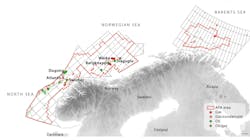Offshore staff
OSLO, Norway – E&P activity on the Norwegian shelf last year delivered 14 discoveries and four new fields went onstream, according to the Norwegian Petroleum Directorate (NPD).
“While 2020 has been an unusual year in many ways with the pandemic and the decline in oil prices, investments on the shelf are at the same level as previous years,” said NPD director general Ingrid Sølvberg.
A total of 31 exploration wells spudded in 2020: of the 14 discoveries, seven were in the North Sea and seven in the Norwegian Sea.
Originally, around 50 exploration wells were planned, but some were postponed due to COVID-19. This year, around 40 exploration wells should be drilled.
The four newly producing fields are Tor and Skogul in the North Sea, and Ærfugl and Dvalin in the Norwegian Sea, all developed through existing infrastructure.
As more of these types of projects are likely in the future, it is essential for infrastructure to be maintained and made available for phase-in of additional resources, the NPD said.
Norway’s oil production was higher last year, in large part due to volumes from the giant Johan Sverdrup field in the North Sea, but total output across the shelf was below expectations due to the production regulation introduced last summer to support OPEC on pricing; project postponements; the shutdown on Snøhvit in the Barents Sea; and the market situation for gas.
Over the next few years Norwegian oil production should rise from the current 1.7 MMb/d to more than 2 MMb/d in 2025.
Gas accounts for just over half of overall production, and this equilibrium looks set to continue for the next eight to 10 years.
Although production is rising, Norway’s offshore emissions have started to decline, in part through increased take-up of power from shore. Based on currently approved plans, CO₂ emissions will be around 3.2 MM metric tons (3.53 MM tons) lower in 2023 than would otherwise have been the case.
If further planned projects are approved, avoided emissions could reach around 4.9 MM metric tons/yr (5.4 MM tons) of CO₂, equivalent to 40% of total emissions from the petroleum industry in 2019.
Norway’s offshore investments in 2020 totaled around NOK150 billion, or $17.6 billion (excluding exploration), 2% up on the figure for 2019.
This year the NPD foresees investments of around NOK140 billion ($16.42 billion), falling back in 2022, and then rising again. This is due to the fact that more new fields are being developed, with further projects being implemented on operating fields.
Last June’s introduction of a temporary tax adjustment is a factor in the increase.
During 2021-22, the NPD expects to receive a high number of new plans for development and operation.
Around 25% of the estimated resources on the shelf still remain to be found. “Our estimates indicate that there is enough oil and gas on the shelf for the petroleum industry to create value for a long time to come,” Sølvberg said.
01/15/2021



